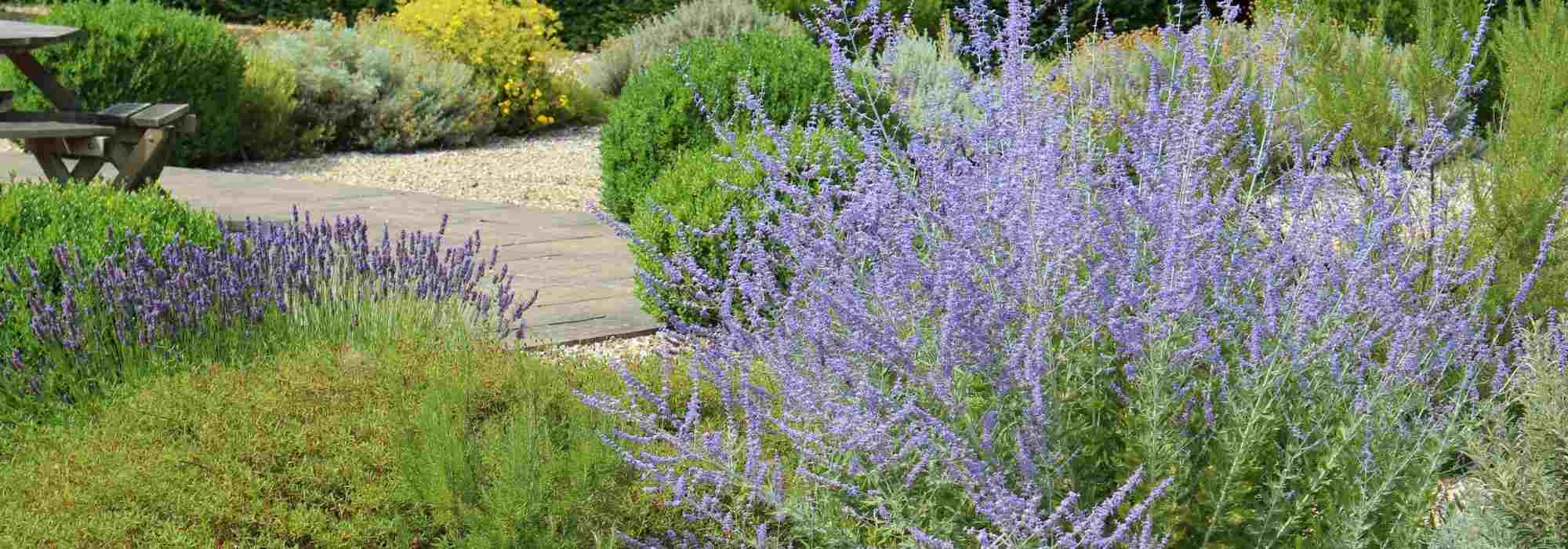
Pairing ideas with Perovskia
9 ideas to invite it to the garden without hesitation
Contents
With its lavender-like appearance, its upright yet airy habit, Afghan sage or Perovskia atriplicifolia is an admirable shrub to introduce to the garden to enjoy both the grey of its foliage and its very long mauve flowering. It is increasingly seen in our outdoor spaces, and for good reason: Perovskia truly looks splendid in pastel beds or in wilder, more free arrangements, in seaside gardens or gravel gardens.
This Russian sage – its other nickname – has more than one string to its bow, as it tolerates both drought and cold, as well as salt spray and pollution. Moreover, it is ideally hardy, allowing it to be used throughout the country.
Let’s see how it enhances different types of gardens through several inspiring scenes!
In a Mediterranean garden
If it is increasingly used in landscaping, it is because Perovskia is one of those “camel” plants that require almost no water once established. It thrives in a Mediterranean garden, which is quite water-wise. Perovskia will provide a very pleasant airy sensation in this garden, where soft hues ranging from white and yellow to purple, along with olive green to bluish foliage, will be emphasised. The shapes will be deliberately chosen to be both opulent and more structured to create a lush garden.
At the foot of an olive tree, a fig tree, or an Acacia dealbata, imagine a scene where several young plants of rosemary, lavender, and santolina will form a very ornamental evergreen base. Boxwoods and blue agaves will visually structure the space. A Phormium tenax ‘Yellow Wave’ will illuminate the whole with its variegated shades of yellow and green. To introduce some vertical elements, nothing beats yellow Kniphofias or Eremurus robustus that thrive in full sun. Don’t forget Cistus and Euphorbia myrsinites, tangy and creeping. To add some warmer colour touches, feel free to plant bold shrubs like Grevillea or Callistemon or even a pink laurel.

Perovskias accompanied by Grevillea juniperina, lavender, cistus, Kniphofias, and an olive tree
In a two-colour scene
The mauve to violet blue of Perovskia is an ideal colour for creating bicolour beds, paired with complementary shades, whether simply white, or with acid green yellows, or bright oranges. This type of bed, playing with contrasts and colour combinations, suits many gardens, whether they are English, rustic, or very natural.
For a classic duo of blue and orange, there are plenty of choices, always respecting the planting conditions of perennials or bushes that require a sunny exposure, well-draining soil, and focusing on drought-resistant plants! The greyish foliage of Perovskia will temper these warm colours, bringing softness and finesse.
Pair it, for example, with Achillea millefolium ‘Terracotta’, bright orange potentillas like ‘Hopley’s Orange’, Heleniums, and a clump of Kniphofias in golden yellow for a generous bed. The bright blue flowers of Delphiniums and the violet hues of a Buddelia will nicely complete the rustic scene, while the lavender blue of Echinops can integrate into more modern beds. A few large clumps of Asters novi-belgii ‘Eventide’ and Chrysanthemum rubellum ‘Mary Stocker’ will extend this bed until October. A grass can be added for even more flexibility.
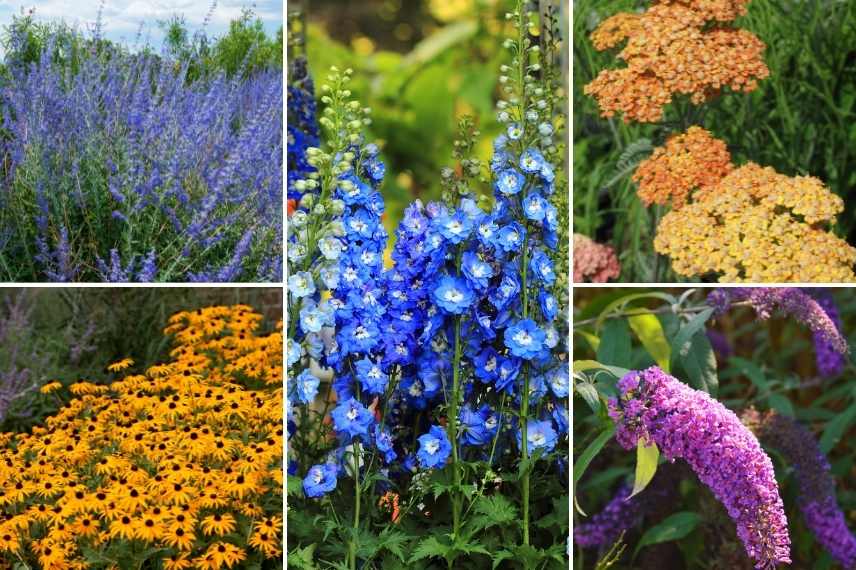
Perovskia, yellow Rudbeckias, Delphiniums, Achillea millefolium ‘Terracotta’, and the violet of a Buddleia.
You can also easily create a less flashy, but equally aesthetic scene, by playing with cream and yellow to chartreuse green shades. These colours will blend well in a naturalistic or more contemporary garden. Consider a subtle composition by pairing Perovskias with a beautiful clump of Helichrysum italicum, lavenders, and rosemaries for a harmony of greyish leaves. Salvia nemorosa will be perfect for a brighter, upright purple touch. Anaphalis, a Kniphofia ‘Ice Cream’, and a Euphorbia characias ‘Glacier Blue’ also play on softness, while a Stipa tenuissima and a shrub rose ‘Golden Wings’ bring charming yellow and golden tones.

The mauve of Perovskia pairs well with more pronounced purples and yellow-green shades and greyish foliage: Kniphofia ‘Ice Cream’, Euphorbia characias ‘Glacier Blue’, Stipa tenuissima, lavenders, Rose ‘Golden Wings’, and Salvia nemorosa
Discover other Perovskia
View all →Available in 4 sizes
Available in 2 sizes
Available in 4 sizes
Available in 3 sizes
Available in 2 sizes
Available in 2 sizes
At the edge of a path or as a low hedge
To edge a path with elegance, Perovskia proves to be a truly ornamental and original choice. Although it is not evergreen in all regions and is cut back in early spring, its growth rate allows it to quickly dress a path in a beautiful, soft, and colourful mass. The foliage even retains an attractive winter appearance south of the Loire, making it quite interesting for creating tall, airy borders that are lovely in natural or English-style gardens. Just like lavender, Perovskia seeks the sun and will naturally incline its stems towards the light: this is what is greatly appreciated in this configuration of medium border or low hedge, about 1m in height.
It can be planted alone in a long, undulating river, but it is better to associate it with other light or contrasting plants, for example, forming a stunning cream and blue duo with a Pennisetum villosum with ivory spikes, or in a more classic path, interspersed with Ilex crenata ‘Golden Gem’ or Euonymus japonicus ‘Microphyllus’ trimmed into large balls. To add rhythm to your Perovskias, Hebe pinguifolia will blend its grey foliage with theirs, while also providing a contrast of texture and form.
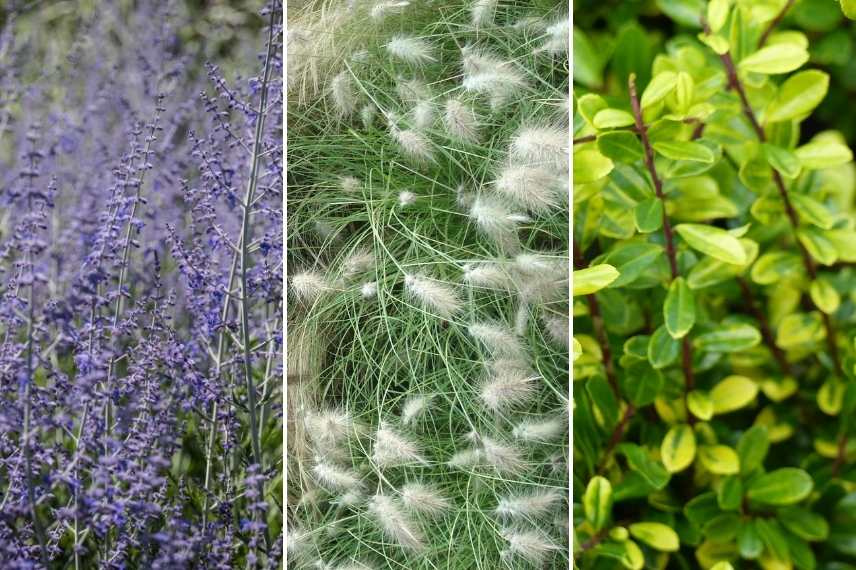
Contrast the colours of inflorescences or the shapes of foliage along a path: here a fluffy Pennisetum villosum full of softness, and a small-leaved evergreen Spindle
Read also
How to create a gravel garden?In a seaside garden
Insensitive and particularly resistant to sea spray, the Russian sage is a shrub well-suited to seaside gardens. It will thrive alongside other plants that flourish in calcareous, sandy, and poor soil, making it perfect for a second home garden, requiring almost no maintenance or watering.
For a beautiful exotic holiday atmosphere, pair it with a Phormium ‘Rainbow Queen’ with its sumptuous pink and bronze variegation, cushions of Pittosporum tobira ‘Nana’, Escallonias ‘Pink Elle’, rosemary, and Gauras as light as it is. The whiteness of the pom-poms of Eryngium yuccifolium and a tuft of Melica ciliata planted nearby will harmonise with the grey of its leaves. Also, install shrubs with remarkable, finely cut foliage such as Melianthus major, a Tamarisk, or an Albizia, along with a Mexican blue palm (Brahea armata). Finally, erigerons will bring a lot of softness to the ensemble.

At the seaside, one can rely on plants from mild climates and beautiful contrasts of foliage: Pittosporum tobira ‘Nanum’, Escallonia ‘Pink Elle’, Brahea armata, and a tamarisk
In a scree garden
Drought-resistant plant, Perovskia thrives in dry spaces, such as a scree garden or mineral garden, or even a rockery. In this context, it is interesting to pair it with low-growing cushion grasses, such as Festuca ‘Intense Blue’, golden Stipas tenuifolia with tousled hair, and flexible Deschampsias flexuosa. You can also rely on the grey tufts of Santolines serratifolia to complete this low, fluffy stratum, which will bloom in a bright yellow that pairs well with Perovskia. Complete your dry bed with some sturdier bushes like Agaves filifera, as well as a Cistus that will bloom early in the season, and succulent plants with some houseleeks ‘Velvet Red’ that turn pink in spring. A few perennial flaxes will also form charming little elegant clouds, all in shades of blue.
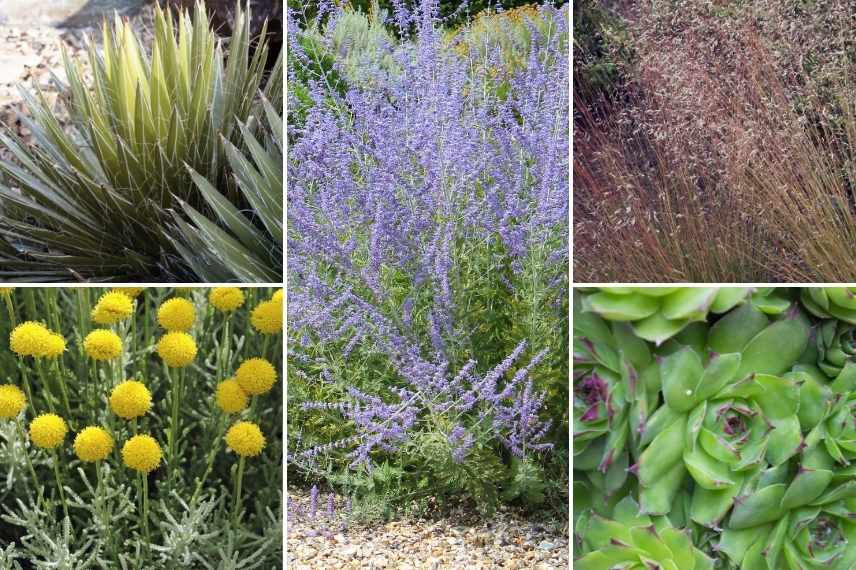
Perovskias associated in a scree garden with some Agaves filifera, Santolines serratifolia, a Deschampsia flexuosa, and houseleeks
In a naturalistic scene
Undoubtedly versatile as long as they grow in well-drained and rather dry soil, Perovskias charmingly enhance naturalistic and wild gardens. Their flexible habit and the softness of their hues work wonders in very pastoral scenes. Combine them with some greyish foliage, as well as more pronounced shades and several tall grasses to evoke a wild meadow. Opt for the typical species, which is large, for these natural scenes.
Some Verbascums phlomoides ‘Spica’ will bring a beautiful verticality to this scene, highlighting their immense white spikes and complementing the velvety grey of their foliage. Plant a beautiful and large Stipa gigantea for lightness, and Calamagrostis brachytricha planted in masses for their blonde appearance. Contrast this with a greener grass like Miscanthus sinensis ‘Gracillimus’, which is very fine, and Bromus sterilis for a truly wild look. Take the opportunity to introduce other equally nectariferous plants as the Perovskia, such as sedums, Buenos Aires Verbenas, Agastaches, or Echinaceas, to name a few.

Perovskias thrive in wild areas, here accompanied by Heleniums, sedums, Bromus sterilis, Verbena bonariensis, Verbascums phlomoides ‘Spica’, and Stipa gigantea
In a scented garden
If sometimes compared to lavender, it is not the flowers per se that scent the air with Afghan sage, but rather its powerfully aromatic foliage. Belonging to the Lamiaceae family and bearing the name sage, it indeed possesses the fragrant attributes of this plant family. Incorporating it into a scented garden is a wonderful way to integrate it alongside other plants with divine fragrances, which will take turns from spring to autumn.
For this use, choose a rather compact form to place at the edge of a flowerbed—in a frequently visited area or near the house—so that you can brush against its foliage, such as ‘Little Spire’, and surround it with perennials and small flowering bushes that bloom alongside it: a fragrant rose, a ‘Natchez’ mock orange, a clump of Helichrysum italicum, heliotropes, and a few other Lamiaceae such as creeping rosemary, golden oregano, and a ‘California Sunset’ jamensis sage. A Daphne transatlantica ‘Eternal Fragrance’ and a Mexican orange blossom will complete this fragrant tableau by blooming simultaneously in spring and late summer.
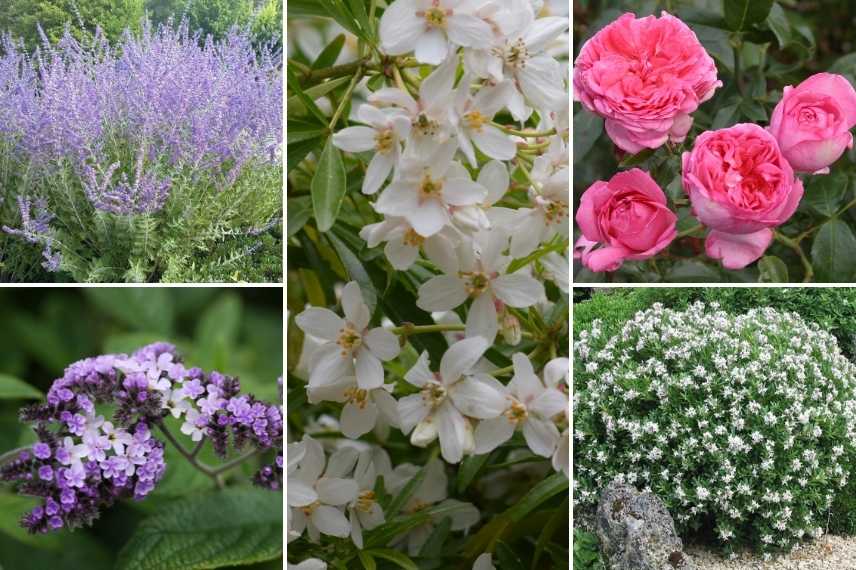
In the scented garden, Perovskia will offer its aromatic foliage, alongside the flowers of Heliotrope, a Choisya ternata, a well-scented rose like ‘Molinard’s rose’, and a Daphne transatlantica ‘Eternal Fragrance’
In a romantic garden
Invite Perovskia into pastel scenes; it is simply magnificent and greatly contributes to infusing charm and softness into a romantic garden.
Alongside delicately upright Veronicastrums , pastel roses, airy Gypsophila , and Nepetas, as well as Phuopsis as groundcover or edging, Oriental poppies, Valerian, garden catchflies, Tulbaghias , and Sedums: all these plants harmonise beautifully with it and will provide successive flowerings for several months.
The variegated cream foliage of a Cornus controversa or the golden hue of a Chinese Viburnum (Viburnum plicatum ‘Shasta’) will add some volume to these shorter perennials. A late-flowering peony like Paeonia officinalis mollis, or a purple-leaved bush can also be considered if you integrate this bed with a flowering of a pronounced violet like the stunning Knautia macedonica.
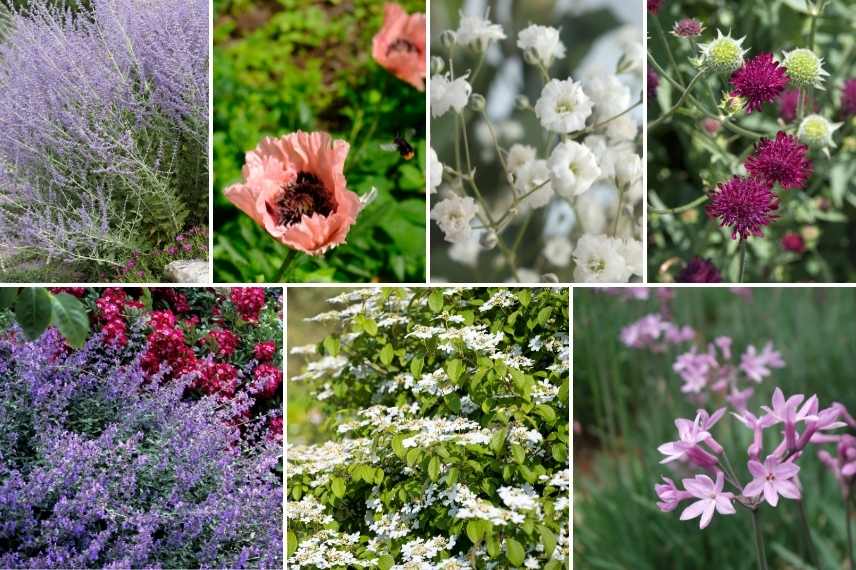 In a romantic-inspired garden, many flowerings are to be expected along with some bushes: here, Oriental poppies, Gypsophila, Knautia macedonica, Nepetas, and roses, a Viburnum plicatum, and Tulbaghias accompany Perovskias…
In a romantic-inspired garden, many flowerings are to be expected along with some bushes: here, Oriental poppies, Gypsophila, Knautia macedonica, Nepetas, and roses, a Viburnum plicatum, and Tulbaghias accompany Perovskias…
In a pot on the terrace
By selecting a small, relatively upright Perovskia, it is possible to grow it in a lovely pot on the terrace or even on a south-facing balcony. The varieties ‘Little Spire’ and ‘Silvery Blue’ are both suitable for this purpose; you will repot them every three years or so once they have established well.
Their blue flowers will beautifully complement a Stoechas lavender. To extend the flowering period, choose soft white and blue colours with some Agapanthus, a sage with deeper violet tones like Salvia nemorosa ‘Mainacht’, a Pittosporum tenuifolium ‘Golf Ball’, and a Cycas revoluta or an agave in milder regions to provide a beautiful contrast of colour and foliage.
→ Learn more about the cultivation of Perovskia in pots with Virginie’s tips!
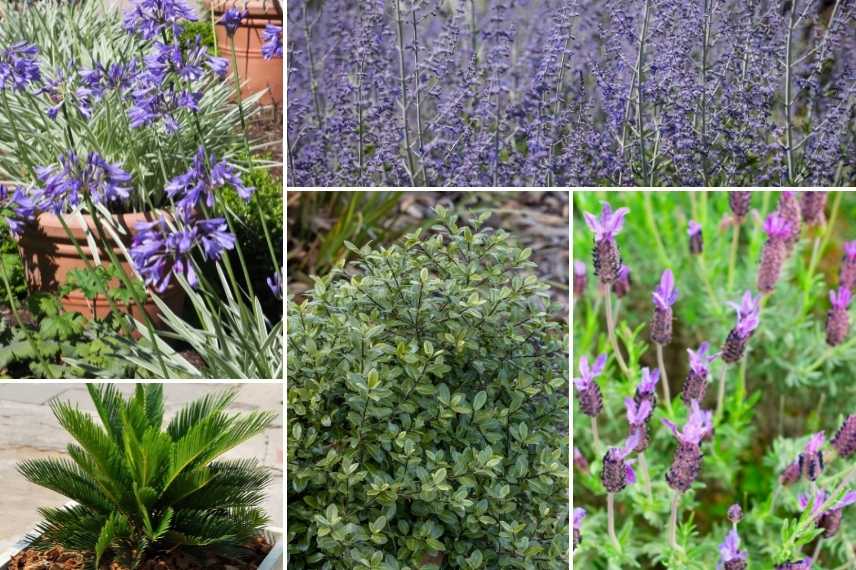
On the terrace, an Afghan sage pairs well with blue or white Agapanthus, a Cycas revoluta, a Pittosporum tenuifolium ‘Silver Ball’, and butterfly lavenders
- Subscribe!
- Contents
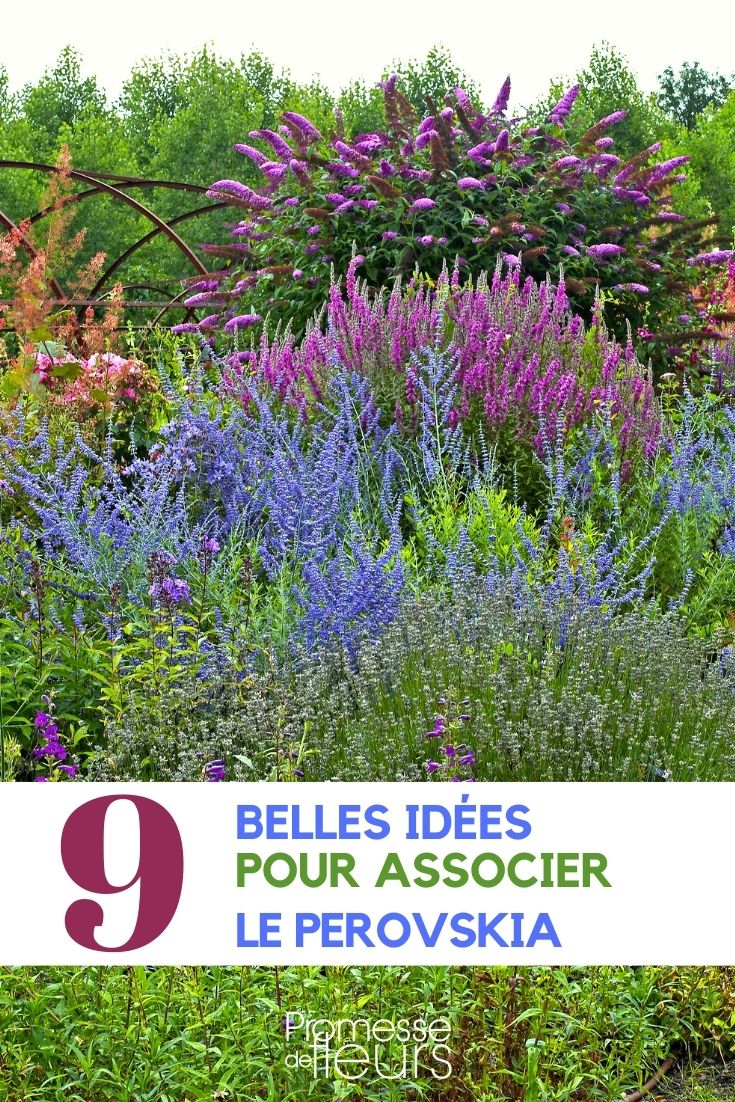
































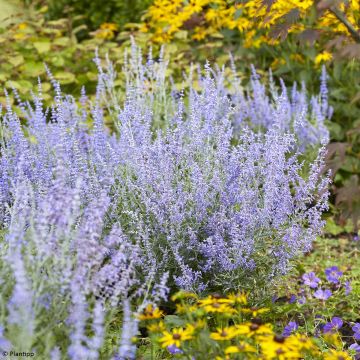
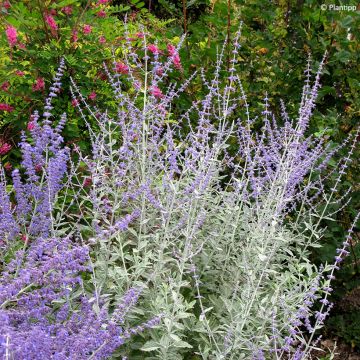

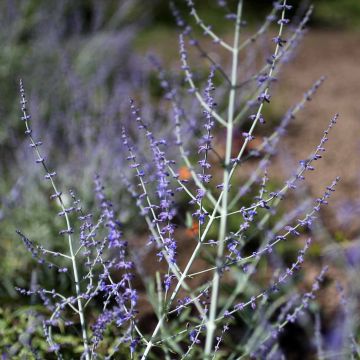
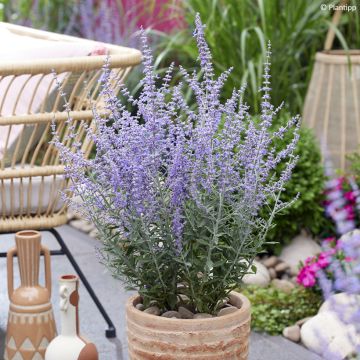
Comments